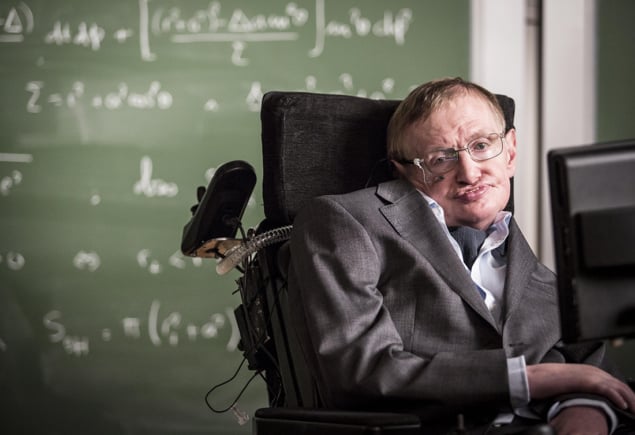
The cosmologist Stephen Hawking has died at age 76 at his home in Cambridge, UK. He achieved worldwide fame for his groundbreaking work on black holes and his great success at bringing physics to a wider audience.
Announcing his death, his children Lucy, Robert and Tim said “We are deeply saddened that our beloved father passed away today.”
Famed for his bestselling popular-science book A Brief History of Time and his battle with motor neurone disease, Hawking carried out ground-breaking research in cosmology, quantum gravity and black holes.
“Very easy” first
Stephen William Hawking was born in Oxford, UK, on 8 January 1942 after his parents moved from London for his birth to escape war-time bombardment of the capital. In 1950 Hawking’s family moved to St Albans in Hertfordshire, where he attended St Albans School. He then received what he later described as a “very easy” first-class degree in physics at the University of Oxford, reputedly only working for an average of about an hour a day for his qualification.
After graduating in 1962, Hawking went to the University of Cambridge, UK, to do a PhD in cosmology, hoping to carry out his research under the guidance of astronomer Fred Hoyle, whom he had admired from childhood. Instead, he worked under the supervision of Denis Sciama, a former graduate student of Paul Dirac.
Eponymous radiation
It was while working in the late 1960s with Roger Penrose, who was then also at Cambridge, that Hawking used Einstein’s general theory of relativity to determine the conditions under which there must be singularities in the early universe and in black holes – regions of space where gravity is so strong that not even light can escape. Using a novel geometric approach to these mathematically complex problems, Hawking showed that singularities are not mathematical curiosities but are a fairly generic feature of general relativity.
Hawking’s next big discovery took place in the early 1970s when, building on the work of the late Jacob Bekenstein, he demonstrated that the area of a black hole’s event horizon – the point of no return for matter falling inward – could be linked to its entropy through a simple equation. In 1974 Hawking then showed that black holes are in fact not completely black, as classical general relativity implies, but that they emit radiation, thus indicating a deep connection between gravity and thermodynamics.

Tributes to Stephen Hawking pour in after physicist’s death aged 76
This “Hawking radiation” arises from quantum fluctuations taking place near a black hole’s event horizon. The fluctuations generate pairs of short-lived virtual particles, one of which is pulled into the black hole by gravity while the other escapes. Hawking published many further papers on black holes, in particular examining the problems for physics associated with the possibility that information can permanently disappear into a black hole – what is known as the black-hole information paradox – and potential resolutions to this effect. He was also influential in efforts to unify quantum mechanics and general relativity – the enduring quest of theoretical physicists.
Richly recognized
Hawking was recognized with numerous awards throughout his career, becoming a fellow of the Royal Society at the age of 32 and being appointed Lucasian Professor of Mathematics in 1979 at Cambridge – a post once held by Isaac Newton. In 1987 he was the inaugural winner of the Dirac medal of prize of the Institute of Physics and in 2006 was awarded the Copley medal of the Royal Society – its oldest and most prestigious award. Hawking also became only the fourth physicist after Edward Teller, John Bardeen and John von Neumann to be given a US presidential medal of freedom, receiving his honour from Barack Obama at a ceremony in the White House in 2009.
Hawking officially retired in 2009, but despite stepping down as Lucasian professor, he remained as an active scientist as director of research at the Centre for Theoretical Cosmology at Cambridge. That year also saw Hawking accept a visiting professorship at the Perimeter Institute for Theoretical Physics in Waterloo, Canada, which opened a major new extension – known as the Stephen Hawking Centre – in 2011. Later the following year he won a “special fundamental physics prize”, worth some $3m, from the Fundamental Physics Prize Foundation set up by the Russian physicist-turned-entrepreneur Yuri Milner.
Medically challenged
Hawking’s many achievements came despite his motor neurone disease, with which he was diagnosed in 1964 while doing his PhD. Far outlasting doctors’ predictions that he would not survive more than two or three years, he nevertheless became increasingly disabled. Initially confined to a wheelchair, by the early 1970s Hawking was unable even to turn the pages of a book. In 1985 he contracted pneumonia while visiting the CERN particle-physics lab near Geneva and needed an operation known as a tracheotomy that meant he could no longer speak.
Hawking subsequently used a distinctive electronic voice synthesizer to communicate – its androidal American accent became his trademark – and increasingly had to rely on a team of nurses for his day-to-day care. Initially, Hawking was able to use a special hand-controlled lever to operate a computer, which let him scan a dictionary of words and spell out sentences. But in later life he lost the ability to even press a lever and actuated the computer by twitching a face muscle.
Fame and fortune
Hawking had three children by his first wife Jane, whom he met at about the time his condition was diagnosed. However, his marriage to Jane became increasingly bitter as she felt sidelined by his growing public fame from his book A Brief History of Time, which he had written in part to help pay for his ongoing medical and nursing costs. As a strident atheist, Hawking also rowed with Jane about her Christian beliefs and the pair divorced in 1991, with details of their unhappy relationship laid bare in her 1999 book Music to Move the Stars, which later inspired the 2014 film Theory of Everything. Hawking remarried in 1995 to his former nurse Elaine Mason, but he filed for divorce from her in 2006.
Hawking sold an estimated 10 million copies of A Brief History of Time, and wrote several other popular science books, including The Universe in a Nutshell and A Briefer History of Time, which was an attempt to make his landmark work more accessible. In 2007 his daughter Lucy – one of three children from his first marriage – also co-wrote an adventure story entitled George’s Secret Key to the Universe with Hawking and a former PhD student Christophe Galfard. In 2010 Hawking published The Grand Design – which he co-wrote with Leonard Mlodinow from the California Institute of Technology – while three years later his own memoirs, entitled My Brief History, appeared.
Perhaps the only true “celebrity scientist”, Hawking’s fame ensured packed auditoriums whenever he gave public lectures at venues that ranged from the Royal Albert Hall in London to the Hall of the People in Beijing. Hawking popped up regularly on television – appearing in The Big Bang Theory, The Simpsons and Star Trek – and even took part in advertisements for Specsavers opticians and the GoCompare price-comparison website. Dramas and documentaries about his life also made it onto the stage and screen, including the play God and Stephen Hawking in 2000 and a two-part TV series on the UK’s Channel 4 in 2008, although these were easily eclipsed in quality by the candid 2013 biopic Hawking, which he co-wrote and narrated.
Never one to shy from publicity, in 2007 Hawking left the confines of his wheelchair while travelling in a zero-gravity simulating aeroplane, having been keen to raise awareness of spaceflight so that potential disaster on Earth does not wipe out the human race, which he feared could happen. He also divided opinion in 2013 after accepting – and then declining – an invitation to speak at a prominent conference in Jerusalem in protest against the policies of the Israeli government. Opponents attacked his decision to boycott the Israeli Presidential Conference, saying his criticism should have had more weight had he delivered them in person.
Lasting legacy
Hawking was regarded by some who knew him as stubborn and irreverent. Some also thought him arrogant, particularly when, at the end of A Brief History of Time, he wrote that the development of a unified theory of physics could lead us to knowing “the mind of God”. But he was nevertheless also willing to admit when he was wrong. In 1997 he and Caltech theorist Kip Thorne bet John Preskill, also of Caltech, that information falling into a black hole is lost forever to the outside universe, in contradiction with quantum mechanics. In 2004 he conceded the bet, having worked out a solution to this “black hole paradox“. To honour the bet he presented Preskill with a baseball encyclopaedia “from which information can be recovered with ease”.
At a special dinner held in Hawking’s honour in 2007 at Gonville and Caius College, Cambridge – where Hawking had a been a fellow since his PhD days – the cosmologist Martin Rees tried to answer the question of why Hawking had become such a cult figure. Rees suggested that “the concept of an imprisoned mind roaming the cosmos” had grabbed the public’s imagination and argued that “if [Hawking] had achieved equal distinction in (say) genetics rather than cosmology, his triumph of intellect against adversity probably wouldn’t have achieved the same resonance with a worldwide public”.
Hawking, however, was always at pains to remind people the he was not “another Einstein”. Indeed, when Physics World polled more than 130 of the world’s leading physicists in 1999 to find out who had made “the most important contributions to physics“, Hawking received just one vote. Nevertheless, he had done, in Rees’s view, “at least as much as anyone since Einstein to improve our knowledge of gravity, space and time”.
“His name will live in the annals of science,” concluded Rees, who ranked him as one of the top 10 theoretical physicists of the time. “Millions have had their cosmic horizons widened by his best-selling books; and his unique achievement against all the odds is an inspiration to even more.”
- Physics World has created a collection of articles and videos linked to the work of Stephen Hawking, including some of the research papers that he wrote.



